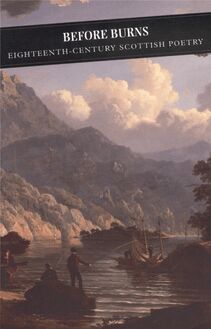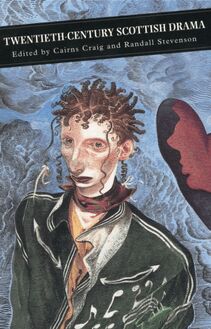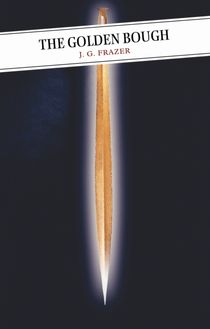-
 Univers
Univers
-
 Ebooks
Ebooks
-
 Livres audio
Livres audio
-
 Presse
Presse
-
 Podcasts
Podcasts
-
 BD
BD
-
 Documents
Documents
-
- Cours
- Révisions
- Ressources pédagogiques
- Sciences de l’éducation
- Manuels scolaires
- Langues
- Travaux de classe
- Annales de BEP
- Etudes supérieures
- Maternelle et primaire
- Fiches de lecture
- Orientation scolaire
- Méthodologie
- Corrigés de devoir
- Annales d’examens et concours
- Annales du bac
- Annales du brevet
- Rapports de stage
La lecture à portée de main
Vous pourrez modifier la taille du texte de cet ouvrage
Découvre YouScribe en t'inscrivant gratuitement
Je m'inscrisDécouvre YouScribe en t'inscrivant gratuitement
Je m'inscrisEn savoir plus
Vous pourrez modifier la taille du texte de cet ouvrage
En savoir plus

Description
Sujets
Informations
| Publié par | Canongate Books |
| Date de parution | 01 juillet 2010 |
| Nombre de lectures | 5 |
| EAN13 | 9781847675934 |
| Langue | English |
Informations légales : prix de location à la page 0,0480€. Cette information est donnée uniquement à titre indicatif conformément à la législation en vigueur.
Extrait
Contents
Introduction
Note on Language and Sources
1 The Battle of Otterburn
2 Kinmont Willie
3 Johnie Armstrang
4 The Battle o’ Harlaw
5 Johnnie o’ Braidiesleys
6 Sir Patrick Spens
7 The Bonny Earl of Murray
8 Edom of Gordon
9 The Bonnie Hoose o Airlie
10 The Baron of Brackley
11 The Gaberlunzie-Man
12 Donald of the Isles
13 Johny Faa, the Gypsy Laddie
14 The Gowans Sae Gay
15 The Wind Hath Blown My Plaid Away
16 The Earl of Rosslyn’s Daughter
17 The Unco Knicht’s Wouing
18 The Fause Knicht
19 The Daemon Lover
20 Burd Ellen
21 The Place Where My Love Johnny Dwells
22 Young Bicham
23 Hind Horn
24 Katharine Jaffray
25 Lord Thomas and Fair Annie
26 Wee Messgrove
27 Bob Norris
28 Lord Thomas and Fair Annet
29 The Twa Sisters
30 Sweet William’s Ghost
31 The Wife of Usher’s Well
32 The Maid of Coldingham
33 Clark Colven
34 The Great Silkie of Sule Skerry
35 Tam Lin
36 Thomas the Rhymer
37 King Orpheus
38 Sir Colin
39 The Twa Magicians
40 The Broomfield Hill
41 Gil Brenton
42 The Broom of Cowdenknows
43 The Shepherd’s Dochter
44 The Shepherd’s Son
45 The Earl of Errol
46 Lord Jamie Douglas
47 The Laird o’ Drum
48 The Cooper of Fife
49 Get Up and Bar the Door
50 Our Goodman
51 The Farmer’s Curst Wife
52 Bog o’ Gight
53 The Laird o Logie
54 Johnie Scott
55 Lang Johnny Moir
56 The Keach i the Creel
57 The Gay Goss Hawk
58 Love Gregor
59 The Drowned Lovers
60 The Dowie Dens o’ Yarrow
61 The Douglas Tragedy
62 Clerk Sanders
63 Lady Maisry
64 The Broom ο the Cathery Knowes
65 The Cruel Brother
66 Son David
67 Rosianne
68 Lady Jean
69 The Broom Blooms Bonnie and Says It Is Fair
70 The High Banks ο Yarrow
71 Willie’s Lady
72 Lamkin
73 The Jew’s Daughter
74 The Cruel Mother
75 Marie Hamilton
76 Earl Richard
77 Lord Thomas and Lady Margeret
78 Lord Ronald
79 Bonny Barbara Allan
80 The Blue Flowers and the Yellow
81 Glenlogie
82 The Twa Corbies
83 The Thrie Ravens
Notes
Index
Introduction
The oral tradition of the Scottish ballads has formed a unique strand in our cultural history. The ballads have made their mark on published literature too, for many writers, most notably Burns and Scott, 1 have drawn inspiration from them, and have been involved in their preservation for these songs were rarely written down by those who sang them, and we depend instead on records of their performance made by collectors. 2
Scottish ballads learnt orally are still being sung in the twentieth century and so in a sense they remain part of contemporary literature. But they are also regarded as ‘old songs’ and indeed they were already regarded in that way at the time of the first wave of collecting in the late eighteenth and early nineteenth century. Some oral genres, such as the short mythological songs of the Baltic region, are of extreme antiquity, but the Scottish ballads, although old, are not extremely old, for their rhymed verse form dates from the late Middle Ages. What can be extremely old about them is their content, since narratives and motifs pass from one genre to another. The riddle contest, for example, found in ‘The Wind Hath Blown My Plaid Away’, ‘The Earl of Rosslyn’s Daughter’, ‘The Unco Knicht’s Wouing’ and ‘The Fause Knicht’ is likely to go back to prehistory.
The earliest references in the ballads to historical characters or events are to the late thirteenth century the time of the earliest named poet in Scots, Thomas of Erceldoune called the Rhymer, who lived in the reign of Alexander III and is the protagonist of ‘Thomas the Rhymer’. Then there is ‘Sir Patrick Spens’ which bears some resemblance to the events of 1290 following the death of Alexander III. These ballads, however, are not known to exist before the eighteenth century, although there is a romance-prophecy of the fourteenth century called Thomas of Erceldoune which may embody parts of an earlier form of a ballad. 3 The earliest case included here of a ballad text nearly contemporary with the events it relates is ‘Edom of Gordon’ which occurs in a late sixteenth-century manuscript. 4
When we try to understand the roots of the ballads as we have them, we must keep in mind how few records have survived even from more recent centuries. When we remember that a ballad could be sung by very many singers and could be sung by one singer on many occasions, we realise that what was picked up by collectors was only a small sample like a bucketful from an ocean. Oral forms are always elusive, of course, but even written or printed records are mere remnants from a vaster stock, now lost. For example, many songs were printed on broadsides or in little pamphlets called chapbooks, and I turned over thousands and thousands of these in libraries on the look-out for a version of ‘Tam Lin’ without ever finding one. And then I was given a copy of an eighteenth-century chapbook containing it by a fellow scholar, Matthew McDiarmid, who had picked it up in a bookshop. Clearly, it was just a matter of chance that this copy survived, although a good many must have been printed. This example is far from being a unique case, for many chapbook and broadside versions of ballads are known in only one or two copies, like the version of ‘The Gaberlunzie-Man’ reprinted here for the first time. Because of the heavy loss of this ephemeral material, it can be assumed that there were many more ballads printed in chapbooks and broadsides which have not survived on paper. In short, we do not have the whole picture and are often reduced to guess-work. 5
In some cases, however, the background to ballads from the eighteenth century onwards has been filled in by the discovery of earlier manuscript versions. One such case is a sixteenth-century manuscript text of ‘Sir Colin’, the discovery of which settled a dispute about whether or not the ballad had early Scottish roots. This is completely ballad-like in parts but it also uses recurrent rhyme which is not at all typical of the ballads. For example, the whole of the lady’s speech to Sir Colin telling him of the adventure by which he may prove his worth and win her hand, and part of his reply, has a recurrent-orn rhyme:
Scho sayis upone yone allreche hill
Thairon standis ane thorn
And ye wald walk ane winter nicht
And baldlie blaw your horn
Ane alreche knycht is mikill of mycht
Will compeir yow biforne
Thair com never ane away with lyf
Sen the first tyme that I was borne
Thair my hand said Sir Collyne
I sail walk at that thorne
Outher ane wad to bring away
Or ellis my lyf to be forlorne 6
When this feature of recurrent rhyme is lost, we have a simplified form contained within the four-line stanza, as in the case of the only use of the -orn rhyme in the later ballad version printed here (‘Sir Colin’, verse 8).
The normal verse for ballads is a four-line stanza with alternate four-stress and three-stress iambic lines rhyming abcb, and this is usually just called ballad metre. A regular example is verse 8 of ‘The Battle of Otterburn’:
But Ο how pale his lady lookd,
Frae aff the castle-wa,
When down before the Scottish spear
She saw proud Percy fa.
Not infrequently, the second and fourth lines are refrains, repeated each time when the ballad is sung, but not printed out in full. In fact, these lines give scope for audience participation in the singing of a ballad.
We should never forget that the ballad is a sung genre 7 with a whole musical dimension that is not caught by the printed text; to gain a full appreciation, every opportunity should be taken of listening to live or recorded performances. 8 Whatever efforts we make, however, we can never recapture contemporary singings of ballad versions from earlier centuries and it is useful, in thinking about this, to separate out the ideas of text and context. 9 The text can be caught in print and transferred bodily from one context to another and may have quite different purposes and effects in different contexts. For example, a singer may sing for his or her own satisfaction without anyone else being present, and can even perform silently in the mind. Then, when an audience is present, the experience may vary in a number of ways. One important variation is the degree to which singer and audience form part of the same milieu. If those listening to a singer are accustomed to hearing ballads sung, they may not need to hear a full version of the story they can fill out the singer’s performance from their own prior knowledge. It is open to the singer, too, in direct contact with an audience to give prose additions to the story and to enter into discussion about the motivation of the characters. In these conditions the ballad is not an isolated entity. Then again, the ballad as performed to be taken down by a collector is in a very special context of its own. Finally, with or without having passed through such an intermediary stage, the ballad may be recontextualised in the course of its history in a drawing-room setting with piano accompaniment or in a folk-club setting, perhaps sung to the guitar.
One broader, less immediate, context is the national one. The early Scottish collectors were driven by a conscious desire to preserve an element of their national heritage and their publications proudly presented their discoveries. The ballads had been Scottish in the sense that they had been collected in Scotland, but they soon became something that provided extra nourishment for Scottish identity.
How Scottish are these ballads? Ballads were transmitted freely among the various English-speaking parts of the British Isles and have been carried overseas by emigrants and other travellers to start up fresh lives in their new settings. 10 It is notable, however, that over a period of several centuries Scotland seems both to have initiated ballads and to have provided an especially hospitable environment for thos
-
 Univers
Univers
-
 Ebooks
Ebooks
-
 Livres audio
Livres audio
-
 Presse
Presse
-
 Podcasts
Podcasts
-
 BD
BD
-
 Documents
Documents
-
Jeunesse
-
Littérature
-
Ressources professionnelles
-
Santé et bien-être
-
Savoirs
-
Education
-
Loisirs et hobbies
-
Art, musique et cinéma
-
Actualité et débat de société
-
Jeunesse
-
Littérature
-
Ressources professionnelles
-
Santé et bien-être
-
Savoirs
-
Education
-
Loisirs et hobbies
-
Art, musique et cinéma
-
Actualité et débat de société
-
Actualités
-
Lifestyle
-
Presse jeunesse
-
Presse professionnelle
-
Pratique
-
Presse sportive
-
Presse internationale
-
Culture & Médias
-
Action et Aventures
-
Science-fiction et Fantasy
-
Société
-
Jeunesse
-
Littérature
-
Ressources professionnelles
-
Santé et bien-être
-
Savoirs
-
Education
-
Loisirs et hobbies
-
Art, musique et cinéma
-
Actualité et débat de société
- Cours
- Révisions
- Ressources pédagogiques
- Sciences de l’éducation
- Manuels scolaires
- Langues
- Travaux de classe
- Annales de BEP
- Etudes supérieures
- Maternelle et primaire
- Fiches de lecture
- Orientation scolaire
- Méthodologie
- Corrigés de devoir
- Annales d’examens et concours
- Annales du bac
- Annales du brevet
- Rapports de stage















